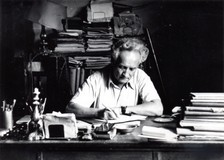
Josip Slavenski (1896–1955), a Yugoslav composer. Born Josip Štolcer to a family of bakers in the Croatian region of Međimurje, he added ‘Slavenski’ to his family name in 1918 and in 1939 made it his official surname. He studied in with Zoltán Kodály in Budapest between 1913 and 1915, with Vítězslav Novák in Prague from 1920 to 1923, and in Paris in 1925–26, where he came into contact with Les Sixes. In Paris, he signed a contract with the renowned music publishers Schott & Sons to publish his works. For a brief time, he found work in Zagreb (1923–24) as a teacher at the Music Academy’s primary school of music but was then dismissed, whereupon he moved and permanently settled in Belgrade. He worked as a professor at the School of Music in Belgrade, the Second Secondary School for Boys, the Music Academy’s Secondary School of Music (1937–45), which in 1955 became independent and today carries his name, and at the Music Academy in Belgrade (1945–55), where he taught composition.
Slavenski was a composer with an elementary power of expression, bold in his explorations of new possibilities of expression; in his oeuvre, he pointed toward new paths of development in the national style, approaching the folk melos from an expressionist perspective. His extensive oeuvre covers all genres of music, except opera. His forms are typically rhapsodic, free, his harmonies are radically free, stepping into the sphere of polytonality and atonality, while his instrumentation rests on laws of acoustics, to which he devoted special attention and which resulted in rather original solutions and extraordinary tone colours.
His most significant vocal-symphonic opus is Simfonija Orijenta (Symphony of the Orient; originally Religiofonija), composed for soloists, choir, and orchestra (1934). Among his symphonic works, especially noteworthy are Balkanofonija (1927) and Četiri balkanske igre (Four Balkan Dances, 1938), orchestral arrangements of his piano suites Sa Balkana (From the Balkans), Jugoslavenska svita (Yugoslav Suite), and Iz Jugoslavije (From Yugoslavia), the symphonic scene Nokturno, Muzika za orkestar (Music for Orchestra, 1936) and Muzika za kamerni orkestar (Music for Chamber Orchestra, 1938). In the domain of chamber music, he produced three string quartets (in 1923, 1928, and 1938); Pjesme moje majke (Songs of My Mother) for alto and string quartet (Fourth String Quartet, 1944); Sa sela (From the Country, 1925), a quintet; Sonata religiosa, for violin and organ (1925); and numerous piano works.
Sonata religiosa for violin and organ, Op. 7, a sonata in one movement, was a rather unusual work when it was composed (1919–25), both in terms of performing forces and the treatment of the organ. The first part contains long, extended chords (Peričić dubbed this chordal pedal point), which entails using special wedges to keep the keys down so that the performer may play on the remaining manuals. Thus the opening chord stems from a harmonic series above C, growing in a big crescendo, while a massive, declamatory theme, the main subject of the sonata, develops below, on the organ pedal. The second section brings relaxation (Misterioso – Meno mosso), with the violin introducing the tuneful second subject. The reprise unfolds with the support of a 12-tone chord.


